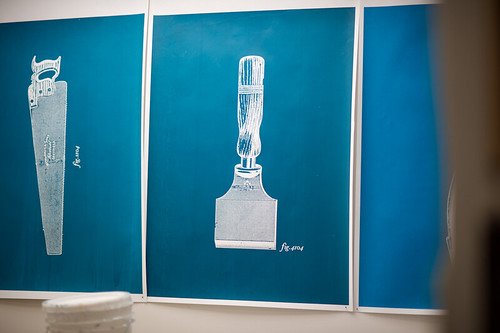Last week was mostly spent in a here-and-there state in the studio. Cleaning things up from a busy prior week in which a very exciting, thoughtful bit of work — about three or four months — went out to be shared. It’s got a good story, a good set of principles behind it and I just love it to death.
There was some preparation for two new-ish projects that sit at the core of what people do when they and one design fiction-y project — or a project that’s super techie in principle and name and all that but that I’ve pretty much decided I’ll take more of an art-historical start at it. It’s basically a take on “augmented” reality and I’ve made my initial reading/viewing list as provocations to get things going, which consists of:
* Jonathan Crary’s Techniques of the Observer: On Vision and Modernity in the 19th Century (October Books)
* The entirety of “They Live”
* Scenes from “Terminator 2”
* Scenes from “Robocop”
* Scenes from “Until the End of the World”
Part of that is to push away from the knee-jerk obvious directions that this could go if it was taken as one of those projects where the name basically tells you what to do. And I think we should stretch our imaginations.
Just a process note to remind myself about why I got a little prickly along the way. If I remember I lost focus — there’s an entry in the increasingly relevant book “101 Things I Learned in Architecture School” that I keep forgetting to look up properly — but the entry basically says the thing you learn from good work in a good studio is how to do good work. It’s less about what gets tooled and manufactured; less about what gets built and all that. It’s learning how to do what you do better than before. I don’t know how that gets captured and how it gets turned into something tangible. Maybe it doesn’t in a pragmatic sort of way. But, especially working in a small studio in an enormous battleship that is in some aft-chamber, out of sight, under the bilge — your perspective changes and your expectations shift upwards toward, like — clarifying, simplifying and translating big lofty ideas. Why did I get prickly? Well — it’s just eagerness and earnestness and excitement bumping up against the need to be patient and remembering to be satisfied that, at the least, we’re doing all the right things.
Think that’s it. There’s more, but that’s it for now.

It is interesting that you’re reading Crary’s excellent “Techniques of the Observer” with a view to engaging with ‘augmented reality’. This kind of ties in to some things that we’ve been addressing in recent research activities. I think there is an issue of how we understand ‘attention’ which is important here, as Crary suggests:
19th century optical devices[…] involved arrangements of bodies in space, which codified and normalised the observer within rigidly defined systems of visual consumption. they were techniques for the management of attention, for imposing homogeneity[…] (Crary, Techniques of the Observer, p. 18)
This raises cultural, economic and political issues about the codification and commodification of attention. As Crary notes from his reading of Foucault, it is in the codification and normalisation of attention that the human subject becomes an object of observation. Just as we can ask questions of the ways in which social networking sites channel attention based upon user data etc. we might also question the ways in which AR might similarly operate.
[PLUG] This was addressed in interesting ways in a recent conference “Paying Attention”:
http://payingattention.org/
which was convened by the Digital Cultures Research Centre, in Bristol (UK) http://www.dcrc.org.uk/
Thanks for the pointers, Sam. I keep coming back to the Crary from when I first read it while working in a Virtual Reality lab at UW back in the day. I’m fascinated by its continuing relevance. This idea of attention is also intriguing; I’m actually interested in attention from a very pragmatic perspective — the draw of the screen and feeds and notifications and all that. What can design do to mitigate the ham-fisted ways in which we’re drawn in to continue to be attentive to everything going on around the expanding, circulating maelstrom of events/activities/updates that I think are driven by this attention economy.